The Royal Return for Eternity: The Homecoming of the Tsar of Bulgaria
In a historic turn of events, 106 years after his exile and 76 years after his death, Tsar Ferdinand I found peace in a dignified place – the new Royal Crypt of the Vrana Palace in Sofia!
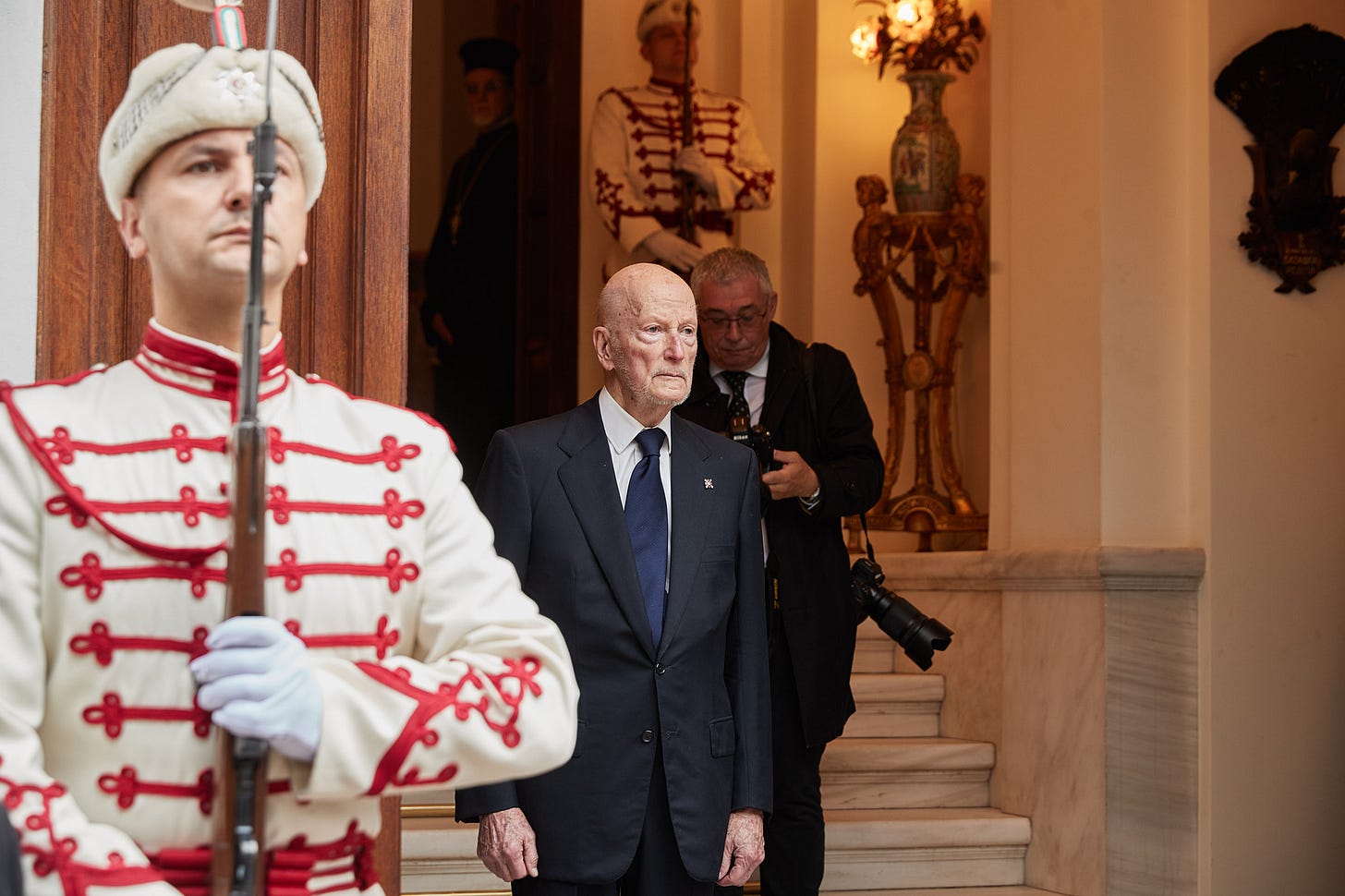
On Wednesday, 27 May 2024 at 2 pm, a C-27J Spartan of the Bulgarian Air Force landed at Sofia airport. On board this aircraft was the coffin containing the mortal remains of Tsar Ferdinand of Bulgaria. Exactly 76 years after his death and 106 years after his abdication he returned to the country he once ruled.
In 1908, Ferdinand of Saxe-Coburg and Gotha revived the Bulgarian Tsardom, the first to wear its new crown. After war and exile, he finally came home to be buried in the new royal crypt of the Vrana Palace.
We are delighted to present to the readers of The Investiture a unique story and an exclusive first-person behind-the-scenes account by our guest writer, Günter Fuhrmann, of the historic royal return and the homecoming of the Tsar of Bulgaria!
Günter Fuhrmann, born on 17 November 1972, in Mistelbach, Austria, is an accomplished author, exhibition curator, and cultural manager. He studied law at the University of Vienna and later completed a master's in cultural management. He became a freelance exhibition curator in 2014 and co-founded Cantat Heritage & Innovation GmbH in 2018. Fuhrmann’s rich opus includes exclusive exhibitions, publications, and historical TV documentaries, which brought him international recognition for his work in cultural heritage and education.
A Coburg from Vienna
Ferdinand Maximilian Karl Leopold Maria of Saxe Coburg and Gotha was born on 26 February 1861 in the glorious Palais Coburg in Vienna. His father was Duke August of Saxe-Coburg, head of the Catholic Koháry branch of the widespread Coburg Family. Originally the Saxe-Coburgs were rulers of the small duchy of Coburg at the border region of Thuringia and Bavaria.
The clan advanced considerably in the 19th century. The grandfather of Ferdinand, Prince Ferdinand Georg of Saxe-Coburg, was an officer in the Habsburg army who married the incredibly rich heiress of the Koháry family, aristocrats of Hungarian descent with property in Upper Hungary, today’s Slovakia. The wealth of the Kohárys was land, mines, and iron works, but due to rules of inheritance, only a Catholic could succeed to this fortune. The Saxe-Coburgs had been keenly Protestant, but for this marriage Prince Ferdinand Georg accepted the Roman faith for his offspring.
Ferdinand Georg’s younger brother was Prince Leopold of Saxe-Coburg, who became the first King of the Belgians in 1831. To secure the rise of the dynasty, Leopold arranged marriages among his nephews and nieces with the royal houses of Europe. Most famous was the match between his nephew Albert and Queen Victoria (whose mother was a Coburg-Saalfeld), but Leopold connected also his Catholic Viennese nephew Ferdinand with Queen Mary II of Portugal, the Portuguese Coburgs ruling the country till the fall of the monarchy in 1910.
Also for the younger Viennese Prince August, son of Ferdinand Georg, and now heir to the enormous Koháry fortune, Uncle Leopold arranged a wedding: the French Princess Clementine d´Orléans, daughter of the Citizen King Louis Philippe.
The Sharp Mind of Princess Clementine d'Orléans
Princess Clementine was famed all over Europe when she married, not for her looks, though she was attractive, but for her intelligence. It was said that she was the smartest princess of her era, a reputation which remained her whole, long life; she died at the age of 90 in the year 1907! Queen Victora particularly liked the smartness of Clem, as she was known in the family. The two women of the same age became best friends and wrote to each other at least weekly.
Clementine and her husband August had a happy marriage and had four children, two sons and two daughters. In the 1850s they settled into the newly built Palais Coburg in Vienna, famous for its garden-facing portico, with its two stories of slender white columns, responsible for the palace´s nickname, Spargelburg – Asparagus castle.
When in 1861 their 5th child was born, both parents were in their mid-forties, so little Ferdinand became the typical youngest child of such parents, especially spoiled by his mother. Clementine was sure that she was destined to become the mother of a king and that Ferdinand should fulfill this destiny. Till this ambitious plan could be implemented, she tried the traditional way of gaining influence – arranging good matches for her other children.
The oldest son and heir of the Koháry-Branch was Prince Philippe, he married Luise, daughter of the Belgian King Leopold II, whose other daughter Stephanie, was the bride of Crown Prince Rudolph, the only son of Emperor Franz Joseph.
The next son was Prince Ludwig August, who was sent to Brazil to marry a daughter of Emperor Pedro II., their children became heirs to the Brazilian Empire, till its fall 1889. Clementine’s daughter Clothilde became the wife of Archduke Josef, head of the Hungarian branch of the Habsburgs, and the other daughter Amalie married Prince Max Emmanuel in Bavaria, a younger brother of the legendary Empress Elisabeth.
Due to his siblings and his cousins in Britain and Portugal the young Prince Ferdinand was closely related to nearly every royal house in Europe, but there was no throne in sight for him. The dream of his mother Clementine of ruling offspring seems impossible to fulfill. But in the year 1886, a military coup shattered one of the young countries at the Balkan…. Bulgaria needed a new ruler!
A Game of Thrones
Bulgaria was a very young country. For centuries part of the Ottoman Empire, an uprising in 1876 tried to liberate it from the Sultan’s rule. Tsar Alexander II of Russia supported the Bulgarians, who reached independence after the Russian-Turkish war. However, during the Congress of Berlin 1878, the European powers accepted only an autonomous principality under the formal rule of the Sultan, but with the Tsar’s nephew Alexander of Battenberg as its ruler.
In 1881 Alexander II was murdered and his son became the new Russian ruler as Alexander III. His Bulgarian cousin tried to rule with more independence from St. Petersburg and came into conflict with the Tsar. In 1886 he was overthrown by a military coup and had to leave the country. Bulgaria remained a principality without a monarch.
A regency council was established to find a new candidate for the throne. No Bulgarian nobility existed, so delegations to the European monarchies were sent to find a potential ruler. Every court refused the offer because it was known that conflict with Russia, which saw Bulgaria as part of its sphere of influence, would be inevitable after accepting this crown.
The Bulgarian delegation also came to Vienna but received only friendly words from Count Kalnoky, the Minister of Foreign Affairs, but no Habsburg candidate. But a great surprise happened during this stay – the delegation got an invitation to the Palais Coburg in Vienna. There, on 14 December 1886, Prince Ferdinand declared his interest in a candidature for the Bulgarian Throne.
The delegation was euphoric, though Ferdinand had been the youngest son of a cadet branch of the Coburg family, he was still very closely related to all the ruling houses of Europe. What they didn’t know was the fact that Ferdinand had not informed his royal relatives, so had no backing from any European power! Even worse, after the news broke—newspapers all over Europe wrote the next day about Ferdinand’s plan, and every European monarch including Queen Victoria and Emperor Franz Joseph opposed this plan, warning Ferdinand to banish this idea.
The only person supporting him was his mother Clementine. At this time she was not only famous for her intelligence, but also her wealth. In the year 1873 the fortune of the Orléans family, nationalized by Napoleon III., was restituted by the French state. Clementine got a sixth of it and became a very rich woman in her own right. With wit and money, Clementine helped her son through the diplomatic games of Europe.
Against all odds, Ferdinand left Austria on 10 August 1887 for his new country, which he had never seen before. Three days later he took an oath in the country’s old capital of Tarnovo, becoming Sovereign Prince of Bulgaria. Nobody in Europe gave him more than a few months, but Ferdinand proved them all wrong. His greatest supporter, his mother, helped him to establish a brand new dynasty on the Balkan. At the age of 70, his mother Princess Clementine travelled in November 1887 to Sofia, the country’s new capital. A glorious rule had begun!
The Great Surprise
Initially, no European power acknowledged Ferdinand’s new position in Bulgaria; for the people, he was just another foreigner who didn’t even speak the language, but in a rather short time Ferdinand changed that. A court life was established in Sofia and the Bulgarian Elite came to the Royal Palace.
Princess Clementine invested great parts of her fortune in the country, among other projects she financed the national railway so that the famous “Orient Express” used the route via Sofia on its way from Paris to Constantinople.
After some years the relations between the Western powers and Bulgaria started to normalize. It was thus time to establish a dynasty; four years after his arrival Ferdinand married Princess Marie Louise of Bourbon-Parma, the oldest daughter of Duke Robert. Her much younger half-sibling Zita, future Empress of Austria, was only two years old in the year of this marriage.

Marie Louise gave birth to four children: first Prince Boris, heir to the throne, Prince Kyrill, and the Princesses Eudoxia and Nadeshda. Like Ferdinand and Marie Louise, the children had been baptized Roman Catholic, but the new Tsar Nicholas II signaled that Russia would accept the new Saxe-Coburg Dynasty as legitimate rulers of Bulgaria if the children became Orthodox Christians. In 1897 this was accepted and the Tsar became the Orthodox godfather of Prince Boris. Marie Louise died in 1899 at only 29 years of age, one day after the birth of her youngest daughter.
The country and its capital changed dramatically in the years of Ferdinand’s reign. Architects mainly from Austria-Hungary started to reshape Sofia before Bulgarian architects, educated in Vienna or Budapest, took over. Schools, academies, hospitals, and cultural institutions were founded all over the country, and with the help of Prussian military advisers, the Bulgarian army became the most modern in the region. A few weeks before the 20th jubilee of Ferdinand´s ascension to the Bulgarian throne his mother Clementine died on February 14th 1907 in Vienna. Till her death at nearly 90 years of age, she had supported the reign of her favorite child.
From Tsardom to Exile
In 1908 the Revolution of the Young Turks shattered the declining Ottoman Empire. The Sultan in Constantinople was still the nominal ruler of great parts of the Balkan Peninsula, including Bulgaria, but the weakness of the Sultanate following the events of the revolution made Ferdinand declare the independence of his country. He reactivated the title of the medieval Tsardom of Bulgaria, which the Ottomans abolished in 1397. It is important to note that while in the Middle Ages, the Bulgarian tsars were reckoned as emperors, Ferdinand and his successors were mostly called kings outside Bulgaria.
Now he was Tsar Ferdinand, ruler of an aspiring country with a strong army. He joined the Balkan League, a quadruple alliance formed by Bulgaria, Greece, Serbia, and Montenegro which aimed to seize control of the European possessions of the Sultan. 1912 they declared the First Balkan War. In a few weeks, the Ottoman troops were shattered, and Ferdinand stood with the Bulgarian army only a few kilometers away from Constantinople.
He saw himself already as the renewer of the Byzantine Empire when the European powers forced the Balkan League into peace negotiations at the London Conference. The Sultanate lost most of its European territory, with Bulgaria as its largest profiteer, but a new alliance of Serbia, Greece, and Romania fought Bulgaria and in the Treaty of Bucharest, summer of 1913, Bulgaria lost most of its gains from the First Balkan War.
In 1915 Bulgaria joined the Central Powers in World War One to avenge its losses from 1913. Ferdinand’s troops occupied Macedonia, regained the Dobruja from Romania, and even conquered parts of Thrace from Greece. However, in the summer of 1918, the pressure from Entente troops against the Bulgarians’ front grew. On 30 September Bulgaria was forced to sign an armistice. Three days later, Ferdinand abdicated his throne in favor of his 24-year-old son Boris and left the country.
The Long Exile
Ferdinand went to the city of Coburg, the historic center of his dynasty. He lived in a small Palais, the Bürglaß-Schlösschen next to the Royal Theater, which has belonged to the Koháry branch of the Saxe-Coburgs for generations. In his exile years, Ferdinand was a great benefactor of his new hometown, supporting social as well as cultural activities. Ferdinand was a well-educated man with many interests, but his true passion was natural science, especially ornithology, Lepidopterology (the scientific study of butterflies), and botany. He financed scientific expeditions and supported the Museum of Natural History in Coburg.
His second residence became Svaty Anton in Slovakia. A Koháry inheritance, the huge baroque manor house was for 15 years Ferdinand’s summer seat. He loved the mountains of the Tatra and possessed several lodges and villas in that region. Till 1944 he visited the country every year, then the occupation of the country by Soviet troops made it impossible.
The last years of his life were quite tragic. In 1943 his oldest son and successor Tsar Boris III died under unclear circumstances in Bulgaria, succeeded by then only six-year-old Simeon II. Regent for the boy-king was his uncle Prince Kyrill, Ferdinand’s 2nd son, but after a communist coup d’etat on 1 February 1945 Kyrill was killed and his mortal remains vanished. In September 1946, the Bulgarian Monarchy was officially ended by the Communists, and the Royal Family, with the 8-year-old King Simeon, were forced to leave the country. Ferdinand watched from exile the end of the dynasty he had founded.
On 10 September 1948 Ferdinand died in his palais in Coburg. He was interred in the Saxe-Coburg-Koháry crypt under the Catholic church of St. Augustin. The church as well as the crypt were founded by Ferdinand’s parents, Duke August and Princess Clementine. Both are buried there in a huge marble double-sarcophagus, modeled after the memorial of Queen Victoria and Prince Albert in the Frogmore Mausoleum at Windsor. Ferdinand ordered to be buried in a transportable coffin, it was called Reisesarg, a huge coffin covered with red velvet. When the time should allow for it, so he stated, he wanted to be brought home.
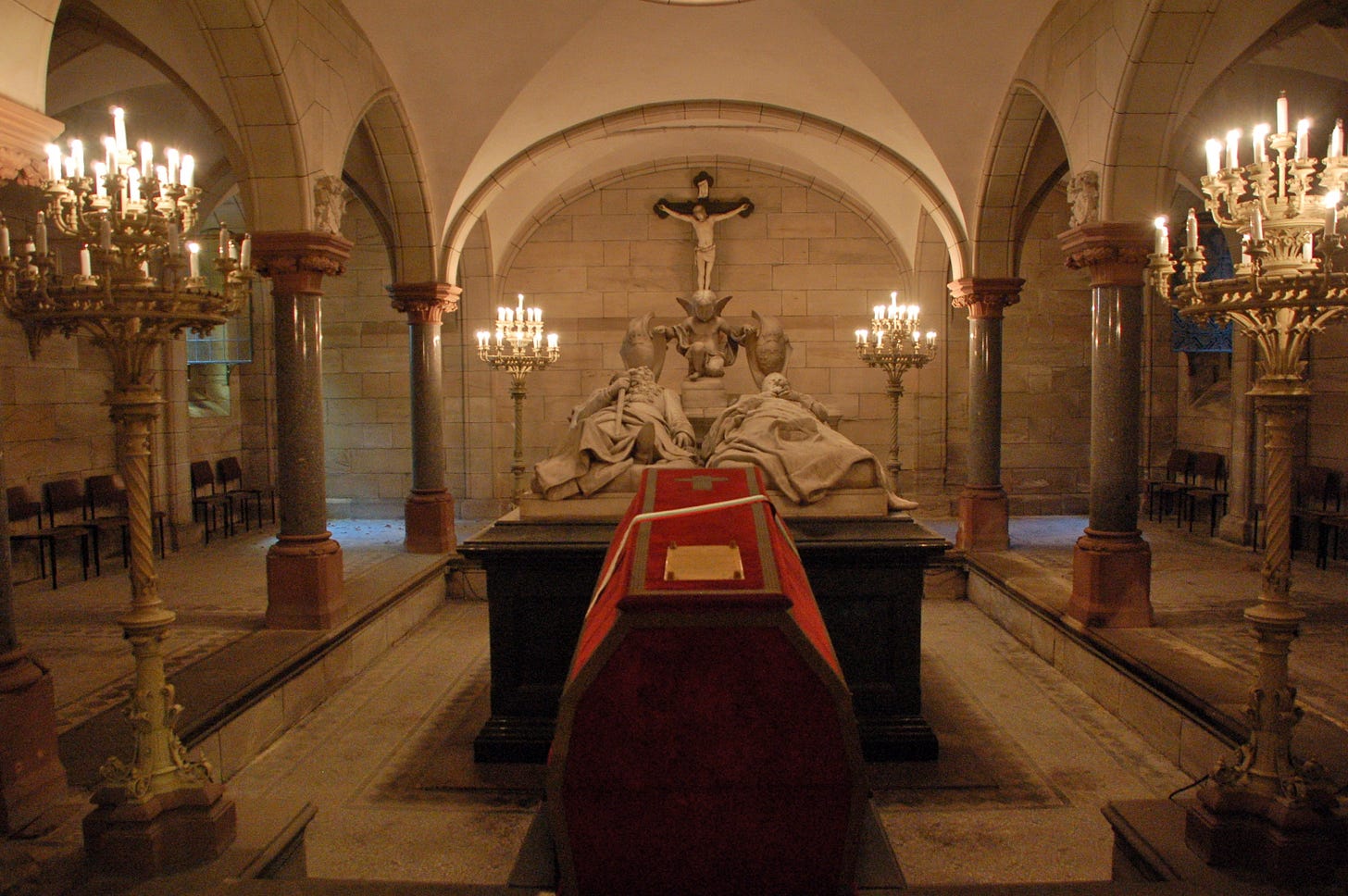
The Return of the King
Ferdinand’s burial in Bulgaria had been impossible throughout the decades due to foreign and domestic political reasons and the complicated international situation. Today, Bulgaria is a full member of the EU and NATO and plays an active role in forming the future of Europe. Divisions of the past, especially how interpretations of history influenced daily politics, became more and more unimportant.
My dear Bulgaria was mentioned many times by the aging Tsar Ferdinand before he left this world. 76 years after his death it became possible to fulfill his wish. The transfer of King Ferdinand's remains was initiated by King Simeon and his sister Princess Maria Luisa. It was organized by Prof. Dr. Peter Stoyanovich, President of the Historical Society of the King Boris and Queen Giovanna Fund, and its director, Ivaylo Shalafov.
Negotiations and preparations for the transfer lasted about six months with varying intensity and were supported by the Bulgarian Ministry of Defense and the Ministry of Foreign Affairs for the final phase. The National Assembly of Bulgaria as well as the President of the Republic approved the project as well as the Council of Ministers. The Holy Synod of the Bulgarian Orthodox Church became one of the strongest supporters of the return of the king’s remains.
The original idea to transport the monarch in the red Reisesarg, his transportable coffin, needed to be altered after a decision of the Bavarian Office for Monuments of Culture. The red coffin should remain in the crypt because it has since become part of the historic interior and will bear the memory of the highly respected Bulgarian king in Coburg further.
Bestattung Kahl, a renowned undertaker from Coburg, was responsible for the reburial of the mortal remains of King Ferdinand into a new coffin. After opening the red velvet Sarkophagus a wooden, then a metal coffin sheltered the body. In an interview Mr. Andreas Kahl, who was present at the opening, described King Ferdinand as surprisingly well preserved, his uniform still intact, holding a cross and prayer book in his hand, his white cane buried with him. The King was laid into a new metal casket inside of a new coffin made of lime wood.
Due to his popularity in Coburg the Roman Catholic Parish of St. Augustin decided to organize a farewell service for the king. On Monday, 27 May 2024 the coffin was brought to St. Augustin and lain in State, covered with a sash in the Bulgarian colors. In the late afternoon at five Peter Fischer, the parish priest of St. Augustin, celebrated the service. In his speech, Dominik Sauerteig, Mayor of Coburg, gave thanks for all the civic contributions by Ferdinand to the citizens of Coburg, and he wished him farewell.
HE Grigor Porozhanov, Bulgarian Ambassador, thanked the city of Coburg for taking such good care of the king’s remains for 76 years. The last speech by Helmut Kollo from the Parish of St. Augustin was a personal farewell to Ferdinand, who had been a frequent visitor to the church during his lifetime and an important part of the historic identity of the parish. The service was attended by many Coburg citizens, most prominent among them Prince Andreas of Saxe-Coburg und Gotha, the current head of the family, and 97-year-old Walter Dorn, who had attended the funeral of Tsar Ferdinand in the year 1948. After the service, the coffin was carried out of the church in a procession and brought to the mortuary.
On the morning of 29 May 2024, Tsar Ferdinand was brought from Coburg to Nürnberg airport in a hearse. At the General Aviation Terminal, a C-27J Spartan with two large Propellers landed at 9:30 a.m. to bring the king home. Accompanying officers from the Bulgarian Air Force carried the coffin together with Andreas Kahl and his colleague into the plane and fixed it in place. At 10:00 the Spartan left Germany, in the direction of Sofia. After a three-hour flight, the aircraft with the remains of the first Tsar of modern Bulgaria touched the ground of the country he once ruled. 106 years after he left, Ferdinand was back in Sofia!
The great hatch of the plane opened and Dr. Peter Stoyanovich and Ivalyo Schalafoff from the King Boris and Queen Giovanna Fund entered. They covered the coffin with the personal standards of the former monarch. Six guardsmen carried the coffin and passing through a guardsman's espalier, loaded it into a mourning vehicle.

At 3:00 p.m., the funeral procession marched from the official entrance of the park to the Vrana Palace on the outskirts of Sofia. It was led by the National Guard band and an Orthodox priest, followed by the hearse, with a guard of four Guardsmen. The procession was led by the grandchildren of the deceased, Princes Kiril Preslavsky and Konstantin-Asen Vidinsky, members and relatives of the royal family, and citizens. Along the central avenue, young men and women from patriotic organizations and students had formed an espalier and joined the procession after the car had passed.
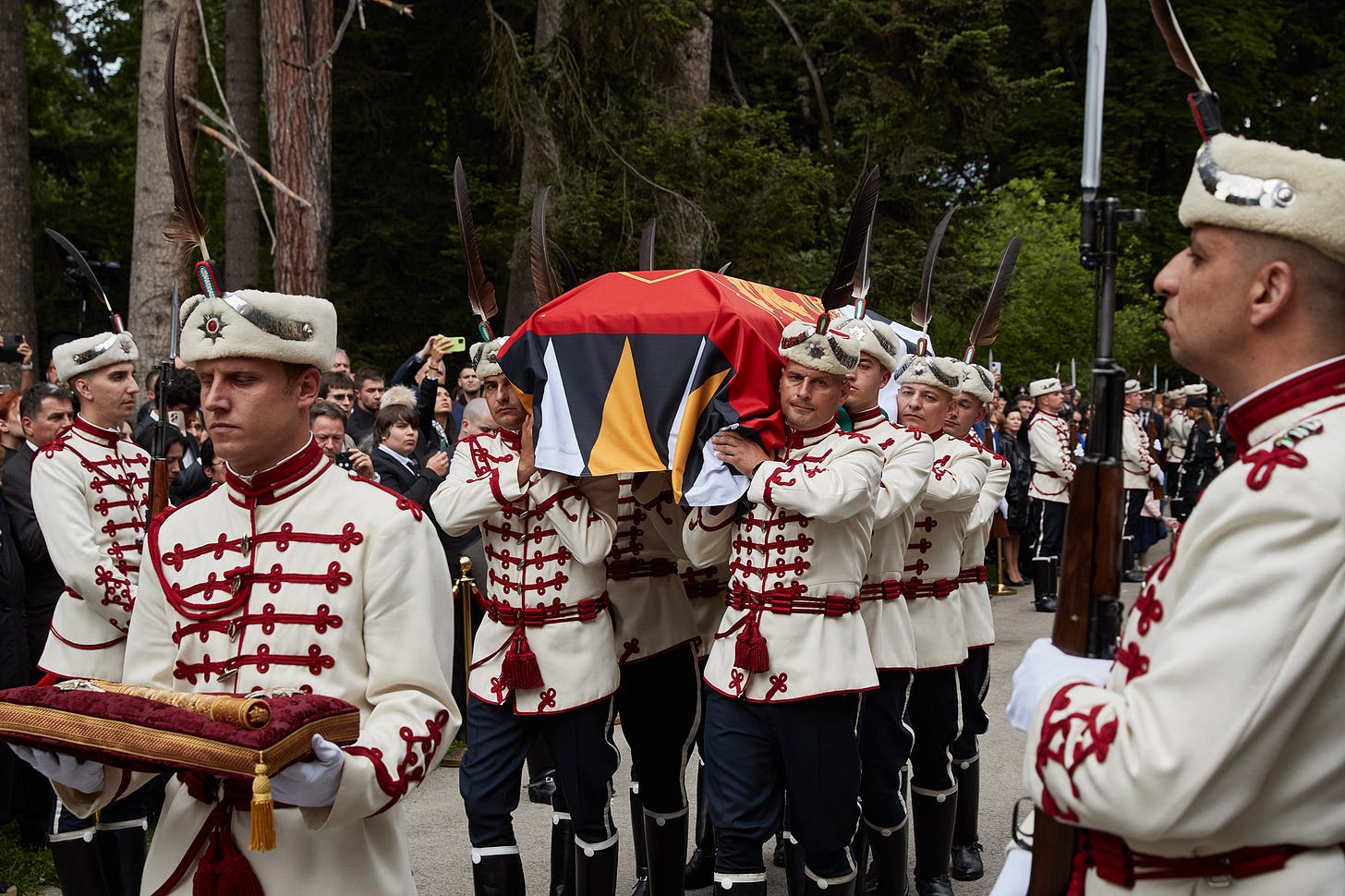
Before the final stretch, six guardsmen shouldered the royal coffin and carried it to the entrance of the palace, where King Simeon and Queen Margarita, other members of the Bulgarian Royal Family, and dignitaries awaited them.
There the six guardsmen waited with the coffin for a moment in silence, surrounded by a huge crowd of participants. Then the first Bulgarian national anthem Shumi Maritza was played and to the sounds of the Mourning March, the remains of Ferdinand entered the Central Lobby of the Vrana Palace, the same building he had erected 120 years ago.

The coffin was placed in the centre and four Guardsmen stood guard around it. His Eminence Metropolitan Anthony of Western and Central Europe celebrated a short homily, with the melodious musical background of 21 choir members from St. Peter's Cathedral. The Apostolic Nuncio to Bulgaria, Archbishop Luciano Suriani, who was present, also celebrated a short homily in the Catholic rite.
Hundreds of people paid their respects to King Ferdinand and waited in long lines outside the palace to say farewell. After lying in state for hours, the doors of Vrana Palace closed in the evening after dark.
The Royal Crypt of Vrana Palace
On Thursday, 30 May 2024 after a short religious ceremony in the Eastern as well as Western Rites, the coffin was carried by the late monarch’s grandchildren Prince Kiril Preslavsky, Prince Konstantin-Asen Vidinsky, Princess Kalina, as well as close friends of the Bulgarian Royal Family, from the entrance hall to the newly adapted crypt of Vrana Palace. The Crypt is located below the Palace church. The first member of the Royal family buried there was Prince Kardam, the firstborn son of King Simeon who died already in 2015, but whose remains were transferred to the new Royal Crypt this past April.
Steps lead down from the palace chapel to the new crypt. The door to the crypt is adorned by a fresco showing the resurrection of Christ. The first room of the crypt is exactly under the chapel and is connected by a door to the burial place of Prince Kardam. The room is vaulted, its walls and ceiling are white, and the floor is covered with green marble. In the center of the room is a tumba made out of red marble, covered with a huge marble plate of the same color with the name and title of Tsar Ferdinand in bronze letters.
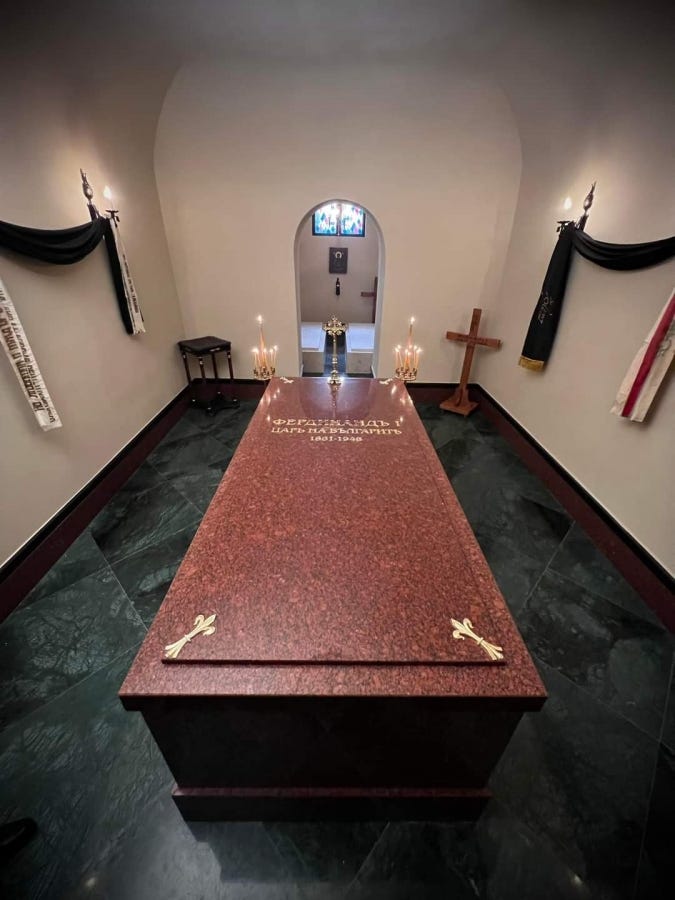
The return of the body of the first monarch of modern Bulgaria was an important historic event in its own right. It was a gesture of reconciliation of a country with its history. Ferdinand became a scapegoat during the Communist period and was accused of many mischiefs, mainly to legitimize the new authoritarian rule of the socialists.
In the last years, a new view of his person and his reign led to a revaluation of Tsar Ferdinand. 106 years after he left his country and 76 years after his death, Tsar Ferdinand shall now rest in peace in a very dignified place – the new Royal Crypt of the Vrana Palace in Sofia.






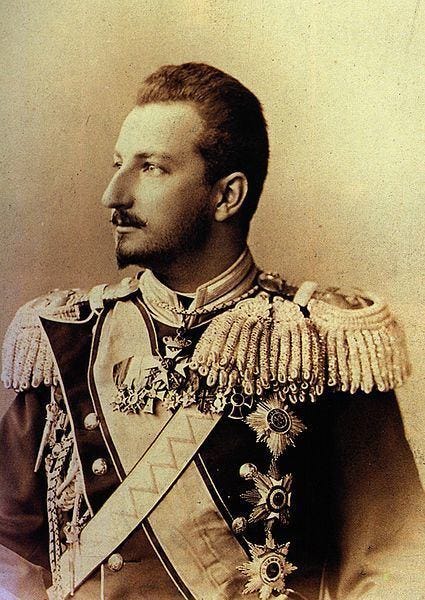
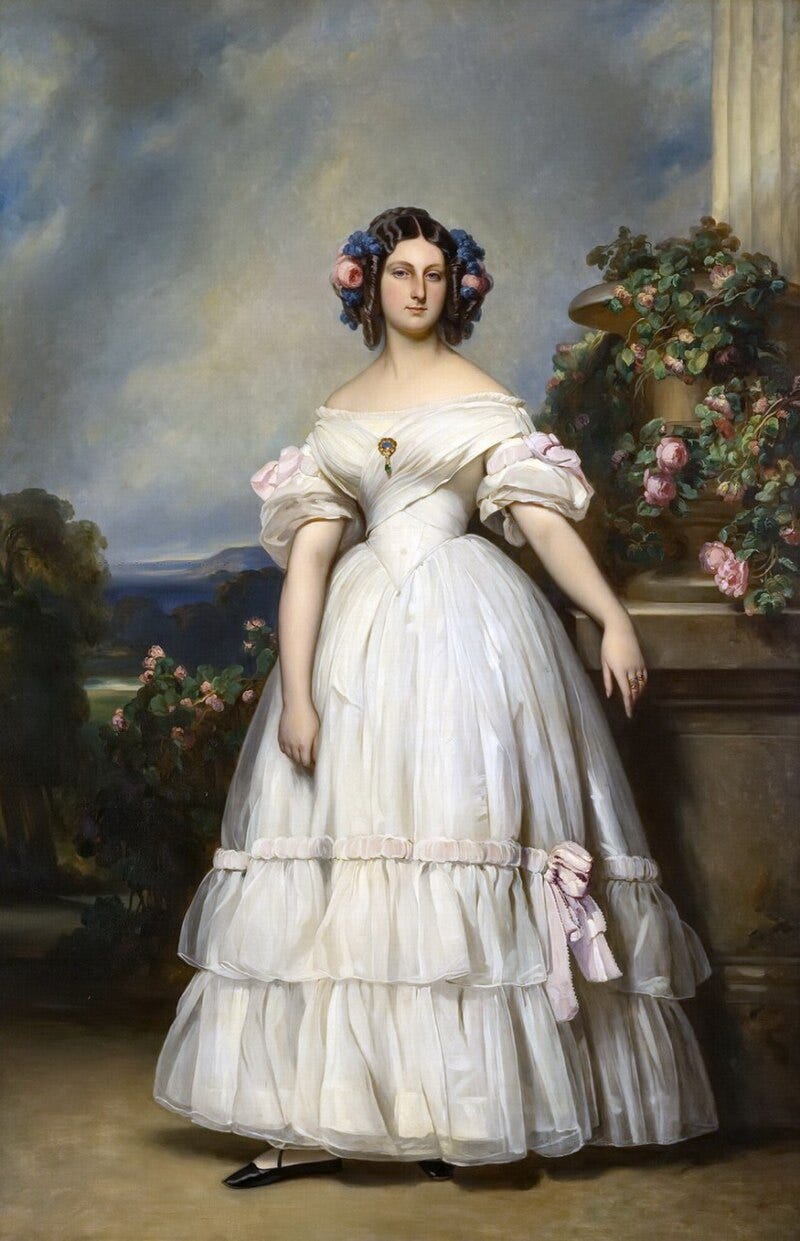



Ein außergewöhnliches Ereignis, dessen Zeuge ich stolz war! Neben einer würdigen Rückkehr ist dieses Ereignis für mich eine Voraussetzung dafür, die Regierungszeit des Fürsten und späteren Königs Ferdinand I. neu zu betrachten und zu überdenken, um eine wahrheitsgeschichtliche Bewertung seines Lebenswerks abzugeben.
Den Beginn dieser öffentlichen Diskussion bildeten die Werke des ehrwürdigen Prof. Petar Stojanovič und insbesondere seine neueste ausführliche Studie, die in der großartigen Publikation „Ferdinandeum“ zusammengefasst ist.
Warm congratulations to all who made this historic home coming possible and my special thanks to Günther Fuhrmann.